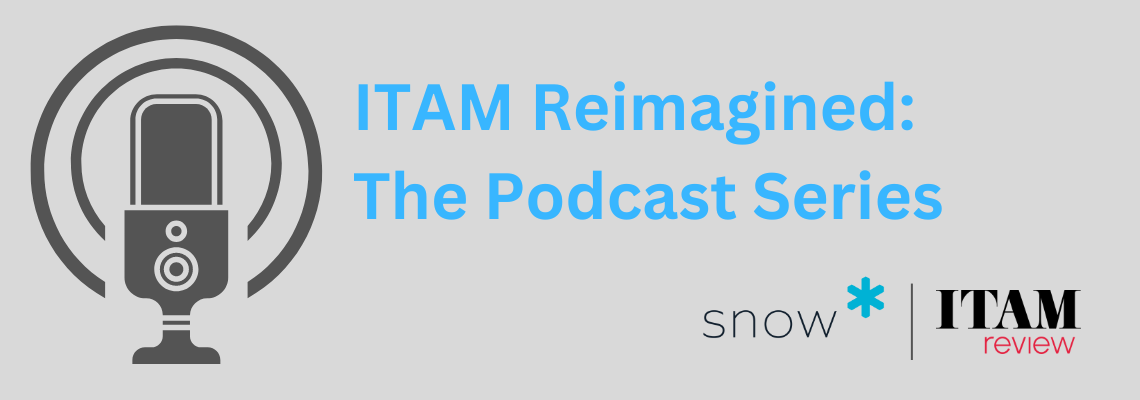The ITAM Review and Snow Software (two ITAM Forum Patrons) just launched an ‘ITAM Reimagined’ podcast series, featuring four ITAM industry leaders:
- Beth Kaminski – IT Asset Program Manager; Dart Container
- David Mackenzie – Head of Service, Asset & Configuration Management; Giganet
- Rick Sheffer – Global Head of Enterprise Asset Management; Wolters Kluwer
- Brandon Smeets – Team Lead ICS User Services; Canon Production Printing
Not only are success strategies shared, but also discussed is how ITAM can be ‘reimagined’ into a strategic business partner position.
Although each episode focuses on a different topic, three themes run loud and clear across all four episodes:
- Data-driven decision making
- Executive speak
- Active listening
Data-driven decision making
Most ITAM teams are trying to increase their relevance and the business benefits they deliver. Reports show that headway is being made – many ITAM teams now report directly to the C-suite and have broadened remits.
But, what if you’re not yet there? What can you do? What should you do?
It’s very easy for someone to say, ‘Just go and talk to your CIO. Request a meeting’. But, how do you get the ITAM conversation going with your C-suite if it’s not already engaged?
According to David Mackenzie, you need to be well prepared with solid evidence. “The C-suite makes very informed decision, so you need informed data.”
And what’s the best way to get this data? Work with your IT Security team. It has access to web traffic. It knows where users are pointing their computers, what portals they are accessing, and more.
“Look at the usage. Who is constantly logging into these portals? This will give you an idea of the cost owner or budget owner. This is the person you want to meet with to discuss how ITAM can help the business make informed decisions.”
Rick Sheffer also agrees about the importance of accurate and timely data — it can help solve C-suite and key stakeholder problems.
“You will become a partner with these stakeholders by showing the value your organisation can bring. You will gain trust, and that will snowball.”
And, Brandon Meets emphasized the following point: share data with multiple stakeholders (across and within departments) rather than just one person.
And this transitions nicely to the next theme: Executive speak
Executive speak
It’s not only important – some would say paramount — to align ITAM to corporate objectives, but you also need to do this in a way that quickly and effectively resonates with your stakeholders. This is a tall order.
Rick says, “You can’t just go and say, we need to count our licenses or computers. They want to know why and what value they will get from it and how it will impact them. Relate the value an ITAM program will bring to their bottom line or how it will make their job easier.”
So, build a data-driven story that will solve a problem, and tell that story in a way they will understand.
Brandon says you have just one minute(!) to discuss where the value lies.
“Talking to the CIO will be different from talking to someone in my team. They don’t have time for a lot of detail. I need to optimize my talking points. If you have 5 minutes, make sure you say exactly what you want to and have more to add…if they are interested in what you’re saying.”
Active listening
How do you build that story? By listening. This is the third key theme.
Communication skills are key to all kinds of success and so are listening skills. Listen to your stakeholders so you understand what they’re trying to achieve.
Says Beth Kaminski, “There’s a lot of directions you can go in with ITAM. That’s one of the things that is so hard about ITAM. How do I get the best/most traction? What is the best direction? Your leadership, your top execs are telling you what those are. Listen.”
Rick provides a great example of how his team listened to what their execs were staying about their organisation going green and reducing its carbon footprint. It used its ITAM data to bring value to the company and to be aligned to this strategic initiative. By taking an inventory of hardware assets and comparing their environment to different sources, including the TCO certified database, they determined their carbon footprint and how they could reduce it.
Says Rick, “If we moved 1, 000 on-prem services to the cloud, we would effectively reduce emissions equal to about 4.8 million kilometres being driven by the average person per year.”
Rick says he doesn’t know if he would have thought about doing this sustainability exercise if he hadn’t listened to what the executives were saying or to the business objective to reduce the organisation’s carbon footprint.
And, it’s not only about listening to your executive team, as Brandon rightfully mentions. You also need to listen to other ITAM professionals and to what’s going on within the ITAM market.
So, how are you re-imagining ITAM? Are you making data-driven decision, speaking ‘exec’ and actively listening?
How are you raising ITAM’s profile?

